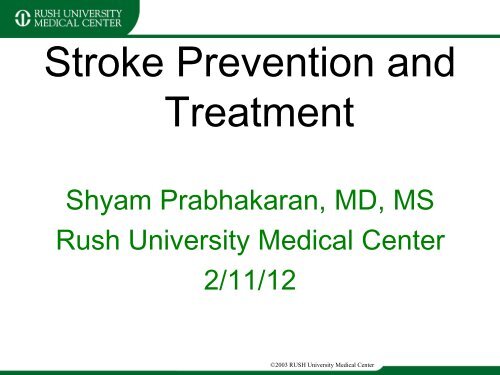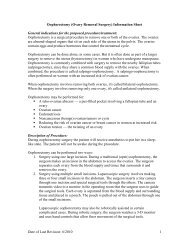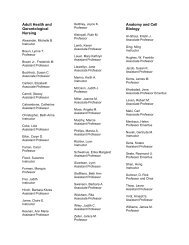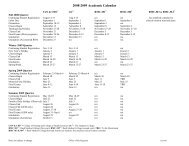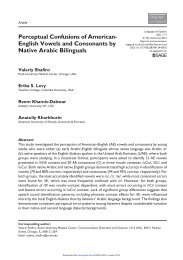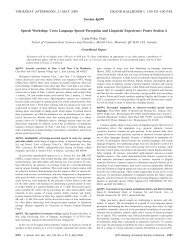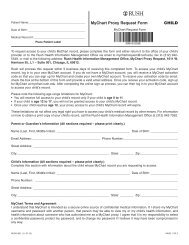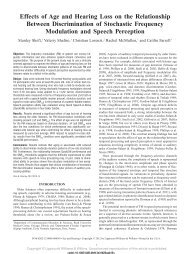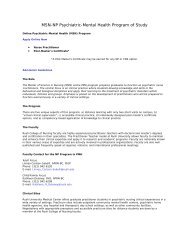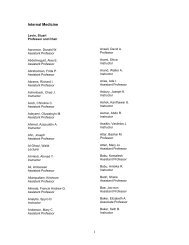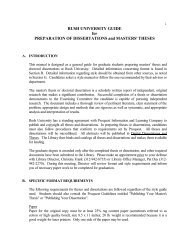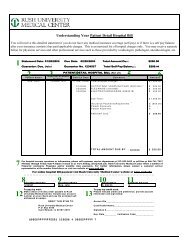Stroke Prevention and Treatment - Rush University Medical Center
Stroke Prevention and Treatment - Rush University Medical Center
Stroke Prevention and Treatment - Rush University Medical Center
Create successful ePaper yourself
Turn your PDF publications into a flip-book with our unique Google optimized e-Paper software.
<strong>Stroke</strong> <strong>Prevention</strong> <strong>and</strong><br />
<strong>Treatment</strong><br />
Shyam Prabhakaran, MD, MS<br />
<strong>Rush</strong> <strong>University</strong> <strong>Medical</strong> <strong>Center</strong><br />
2/11/12<br />
©2003 RUSH <strong>University</strong> <strong>Medical</strong> <strong>Center</strong>
Public Awareness<br />
©2003 RUSH <strong>University</strong> <strong>Medical</strong> <strong>Center</strong>
Public health impact of stroke<br />
• 1 stroke every 40 seconds in the US<br />
– 780,000 new strokes per year<br />
– 150,000 transient ischemic attacks per year<br />
• 1 of 6 Americans will be affected in a lifetime<br />
• 4 th leading cause of death<br />
– Every 3 minutes someone dies of a stroke<br />
– 175,000 per year: 25% mortality<br />
• Leading cause of major disability<br />
• About 4.8 million stroke survivors<br />
• Economic burden: $64 billion/year in the US<br />
©2003 RUSH <strong>University</strong> <strong>Medical</strong> <strong>Center</strong>
Knowledge about stroke<br />
• General public awareness is poor (Pancioli AM 1998)<br />
– 43% could not identify 1 warning sign<br />
– 32% could not identify 1 risk factor<br />
• Up to 40% of stroke patients cannot identify<br />
symptoms, signs, or risk factors for stroke (Kothari R<br />
1997)<br />
• Knowledge is worse among elderly, <strong>and</strong><br />
especially among women <strong>and</strong> minorities (Ferris A<br />
2005)<br />
• Awareness of time-dependent treatments such<br />
as clot-busting agents (tPA) is also less than<br />
optimal<br />
©2003 RUSH <strong>University</strong> <strong>Medical</strong> <strong>Center</strong>
• Knowledge is POWER<br />
Fixing the problems<br />
– Public <strong>and</strong> medical education<br />
– Recognize stroke symptoms <strong>and</strong> risk factors<br />
• TIME IS BRAIN<br />
– Realize that there are approved <strong>and</strong> effective<br />
treatments<br />
• Clot busters (TPA)<br />
• Surgeries<br />
• Medications<br />
©2003 RUSH <strong>University</strong> <strong>Medical</strong> <strong>Center</strong>
=<br />
EACH MINUTE THAT THE BRAIN DOESN’T RECEIVE<br />
BLOOD FLOW, 1.9 MILLION NEURONS DIE<br />
COMPARED TO NORMAL AGING, THE BRAIN AGES 36<br />
YEARS AFTER AN ISCHEMIC STROKE<br />
Saver J. <strong>Stroke</strong> 2006. Jan;37(1):263-6.<br />
©2003 RUSH <strong>University</strong> <strong>Medical</strong> <strong>Center</strong>
What is a stroke?<br />
©2003 RUSH <strong>University</strong> <strong>Medical</strong> <strong>Center</strong>
Types of stroke<br />
• Ischemic stroke – persistent blockage of<br />
blood vessel<br />
• Transient ischemic attack – temporary<br />
blockage of blood vessel<br />
• Hemorrhagic stroke – rupture of blood<br />
vessel<br />
©2003 RUSH <strong>University</strong> <strong>Medical</strong> <strong>Center</strong>
• <strong>Stroke</strong> as in “struck down”<br />
What’s in a name?<br />
– Emphasizes the suddenness but suggests<br />
that it is something out of our control<br />
• Other technical (confusing) terms<br />
– Cerebrovascular accident (CVA), cerebral<br />
infarction, cerebral thrombosis<br />
• From a public health perspective, “brain<br />
attack” may be more preferable<br />
– Similar to “heart attack”<br />
©2003 RUSH <strong>University</strong> <strong>Medical</strong> <strong>Center</strong>
©2003 RUSH <strong>University</strong> <strong>Medical</strong> <strong>Center</strong>
Brain Attack: Warning Signs<br />
©2003 RUSH <strong>University</strong> <strong>Medical</strong> <strong>Center</strong>
Common symptoms<br />
• Paralysis (usually one-sided)<br />
• Language or speech<br />
disturbance<br />
• Blindness in one or both eyes<br />
• Numbness (usually one-sided)<br />
• Double vision<br />
• Vertigo<br />
• Imbalance<br />
• Loss of consciousness<br />
©2003 RUSH <strong>University</strong> <strong>Medical</strong> <strong>Center</strong>
Unilateral Paralysis<br />
• Weakness, clumsiness, or heaviness.<br />
Involves h<strong>and</strong>, arm, face, or leg, alone or in<br />
combination, most commonly the h<strong>and</strong> <strong>and</strong><br />
face<br />
• Droop on one side of the face may occur<br />
(facial palsy)<br />
• The involved body parts are opposite the side<br />
of the diseased artery<br />
©2003 RUSH <strong>University</strong> <strong>Medical</strong> <strong>Center</strong>
Visual Disturbance<br />
• Blurred or indistinct vision in one side of<br />
the field of vision in both eyes<br />
• Involved visual field is opposite the side<br />
of the diseased artery<br />
©2003 RUSH <strong>University</strong> <strong>Medical</strong> <strong>Center</strong>
Double vision<br />
• Perception of<br />
two images<br />
instead of one<br />
due to<br />
misalignment of<br />
the eyes<br />
©2003 RUSH <strong>University</strong> <strong>Medical</strong> <strong>Center</strong>
Vertigo<br />
• An illusion of<br />
movement<br />
caused by a<br />
dysfunction of<br />
equilibrium<br />
centers of the<br />
nervous system<br />
©2003 RUSH <strong>University</strong> <strong>Medical</strong> <strong>Center</strong>
Brain Attack: Risk Factors<br />
©2003 RUSH <strong>University</strong> <strong>Medical</strong> <strong>Center</strong>
• Age<br />
Things you CAN’T change<br />
– Risk doubles each decade after 55<br />
• Gender<br />
– Men have 50% higher risk as women<br />
• Race-Ethnicity<br />
– African-American, Hispanic, <strong>and</strong> Asians<br />
have 2x risk as Caucasians<br />
• Genetics / Heredity<br />
– First-degree relatives at higher risk<br />
©2003 RUSH <strong>University</strong> <strong>Medical</strong> <strong>Center</strong>
• High blood pressure (hypertension)<br />
• Tobacco use (smoking)<br />
• High cholesterol <strong>and</strong> obesity<br />
• Carotid artery narrowing<br />
• Prior transient ischemic attack<br />
• Irregular heart rhythm (atrial fibrillation)<br />
• High sugar (diabetes)<br />
• Other heart diseases<br />
Things you CAN change<br />
©2003 RUSH <strong>University</strong> <strong>Medical</strong> <strong>Center</strong>
High blood pressure<br />
• Most important risk factor for stroke,<br />
both ischemic <strong>and</strong> hemorrhagic<br />
• Normal blood pressure is < 120/80<br />
mmHg<br />
• Risk rises steadily with higher blood<br />
pressures above this level<br />
• <strong>Treatment</strong> with blood-pressure lowering<br />
pills reduces risk of stroke by 40%<br />
• <strong>Treatment</strong> should also include weight<br />
loss, salt restriction, <strong>and</strong> exercise<br />
©2003 RUSH <strong>University</strong> <strong>Medical</strong> <strong>Center</strong>
©2003 RUSH <strong>University</strong> <strong>Medical</strong> <strong>Center</strong>
• One in four Americans<br />
still smoke<br />
• Increasing among<br />
young women<br />
• Smoking doubles risk<br />
of stroke<br />
• Smoking cessation<br />
can reduce stroke risk<br />
to normal within 2 – 5<br />
years<br />
Smoking<br />
©2003 RUSH <strong>University</strong> <strong>Medical</strong> <strong>Center</strong>
• 6 of 10 Americans are<br />
overweight or obese<br />
• 1 in 4 have high<br />
cholesterol<br />
• Cholesterol lowering<br />
therapy with “statins”<br />
reduces risk of stroke<br />
by 30% in primary <strong>and</strong><br />
secondary prevention<br />
• Weight loss, exercise,<br />
<strong>and</strong> balanced diet<br />
must be part of every<br />
healthy lifestyle<br />
High cholesterol<br />
©2003 RUSH <strong>University</strong> <strong>Medical</strong> <strong>Center</strong>
• 5-10% of general population have<br />
narrowing of carotid arteries<br />
• Significant narrowing (> 60%) can<br />
increase risk of stroke 2-fold<br />
• Early identification <strong>and</strong> aggressive<br />
risk factor control is warranted<br />
• Opening of narrowed arteries in<br />
addition to medical therapies can<br />
reduce risk of stroke in selected<br />
patients<br />
Narrowing of arteries<br />
– Most beneficial if after prior stroke or TIA<br />
©2003 RUSH <strong>University</strong> <strong>Medical</strong> <strong>Center</strong>
Carotid artery stenting<br />
©2003 RUSH <strong>University</strong> <strong>Medical</strong> <strong>Center</strong>
Gorelick, PB. Arch Neurol. 1995; 52: 347-355.<br />
Primary <strong>Prevention</strong><br />
Up to 80% of all<br />
strokes are<br />
preventable!!<br />
©2003 RUSH <strong>University</strong> <strong>Medical</strong> <strong>Center</strong>
Transient ischemic attack (TIA)<br />
• 15-20% of stroke patients have a TIA prior<br />
to the stroke, usually within a week<br />
TIA is an<br />
– TIA is a “warning sign” of an impending stroke<br />
– Analogous emergency to a minor tremor <strong>and</strong> before a major<br />
earthquake<br />
an opportunity<br />
• Symptoms <strong>and</strong> risk factors for TIA <strong>and</strong><br />
stroke are identical to intervene except that to TIA is<br />
short-lived prevent (usually minutes stroke<br />
to 1 hour)<br />
• 5% of TIA patients have strokes within 48<br />
hours of the TIA <strong>and</strong> 11% within 3 months<br />
©2003 RUSH <strong>University</strong> <strong>Medical</strong> <strong>Center</strong>
Guidelines<br />
• Acute hospitalization is recommended for:<br />
Timeframe Patients should go to<br />
Within 48 hours of 1 st TIA<br />
Multiple recurrent TIAs<br />
(crescendo) within past 7 days<br />
Within 7 days of 1 st TIA if:<br />
>1 hour duration<br />
ABCD 2 score > 3<br />
High-risk co-morbidity<br />
Carotid stenosis<br />
Atrial fibrillation<br />
©2003 RUSH <strong>University</strong> <strong>Medical</strong> <strong>Center</strong><br />
Emergency<br />
department<br />
Emergency<br />
department<br />
Emergency<br />
department<br />
Johnston SC, Ann Neurol 2006
ED<br />
Acute <strong>Stroke</strong> Team<br />
Head CT<br />
ECG<br />
Basic labs<br />
Admit <strong>Stroke</strong> Service<br />
MRI/A or CTA or Doppler<br />
Cardiac echo <strong>and</strong> monitor<br />
Specific labs<br />
TIA Express Service<br />
Suspected TIA<br />
Within 48 hrs<br />
Crescendo<br />
High risk<br />
Yes No<br />
©2003 RUSH <strong>University</strong> <strong>Medical</strong> <strong>Center</strong><br />
<strong>Stroke</strong> Clinic<br />
Behavioral modification<br />
Smoking cessation<br />
Weight loss<br />
<strong>Stroke</strong> education<br />
<strong>Medical</strong> management<br />
Antithrombotic therapy<br />
Blood pressure control<br />
Lipid lowering therapy<br />
Glycemic control
Patient after<br />
stroke or TIA<br />
Cardioembolic<br />
stroke<br />
Oral anticoagulants:<br />
1. Warfarin<br />
2. Dabigatran<br />
3. Rivaroxaban<br />
RELY, NEJM 2009; ACTIVE NEJM 2009; ARISTOTLE<br />
NEJM 2010; ROCKET-AF NEJM 2010<br />
Cardioembolic stroke - AFib<br />
Warfarin reduces risk of<br />
stroke by 68%<br />
Aspirin reduces risk of stroke<br />
by 21%<br />
Contraindication<br />
to warfarin?<br />
YES<br />
NO<br />
©2003 RUSH <strong>University</strong> <strong>Medical</strong> <strong>Center</strong><br />
Initiate<br />
Oral<br />
anticoagulant<br />
Initiate<br />
1. aspirin or<br />
2. clopidogrel/aspirin
Cardioembolic stroke - AFib<br />
• Patients with ischemic stroke or TIA with persistent or<br />
paroxysmal (intermittent) AF<br />
– Recommended:<br />
• Anticoagulation with adjusted-dose warfarin<br />
(target INR 2.5, range 2.0 to 3.0)<br />
(Class I, LOE A)<br />
• Patients unable to take oral anticoagulants<br />
– Recommended: Aspirin 325 mg per day<br />
(Class I LOE A)<br />
– Clopidogrel plus aspirin is slightly better than aspirin<br />
alone (RRR 11%) in those who are not eligible for<br />
warfarin (ACTIVE NEJM 2009; 360:2066-2078)<br />
• Direct thrombin <strong>and</strong> Factor Xa inhibitors (dibigatran,<br />
rivaroxaban) has lower embolic stroke risks than<br />
warfarin with similar hazards <strong>and</strong> less concern<br />
regarding monitoring <strong>and</strong> dose adjustment<br />
©2003 RUSH <strong>University</strong> <strong>Medical</strong> <strong>Center</strong>
Impact on # <strong>Stroke</strong>s/Year<br />
0<br />
-10000<br />
-20000<br />
-30000<br />
-40000<br />
-50000<br />
-60000<br />
BP<br />
lowering<br />
After<br />
ACEI/<br />
stroke/TIA,<br />
Smoking<br />
Indapamide Statin Antiplatelet Cessation<br />
-36,960<br />
-35,840<br />
per year (80% of<br />
-44,600<br />
Hankey; Lancet 1999;354:1457-63.<br />
Secondary <strong>Prevention</strong><br />
over 200,000<br />
recurrent strokes<br />
can be prevented<br />
total)<br />
-56,700<br />
©2003 RUSH <strong>University</strong> <strong>Medical</strong> <strong>Center</strong><br />
Anticoag.<br />
for<br />
Atr. Fibrl.<br />
-23,520 -23,800
Brain Attack: <strong>Treatment</strong><br />
©2003 RUSH <strong>University</strong> <strong>Medical</strong> <strong>Center</strong>
Acute <strong>Treatment</strong>s<br />
Time window <strong>Treatment</strong> Study<br />
0-4.5 hours IV rt-PA 0.9 mg/kg NINDS<br />
ECASS III<br />
0-6 hours IA pro-UK (rt-PA) PROACT<br />
MELT<br />
0-8 hours mechanical extraction MERCI<br />
PENUMBRA<br />
©2003 RUSH <strong>University</strong> <strong>Medical</strong> <strong>Center</strong>
% Favorable<br />
50<br />
40<br />
30<br />
20<br />
10<br />
0<br />
Clot Busters<br />
Global Test OR=1.7 (1.2-2.6) p=0.008<br />
60-70% more<br />
50<br />
likely to 38 have<br />
39<br />
31<br />
26<br />
20<br />
favorable<br />
outcome if<br />
treated with tPA<br />
NIHSS Barthel Modified<br />
Rankin<br />
44<br />
©2003 RUSH <strong>University</strong> <strong>Medical</strong> <strong>Center</strong><br />
32<br />
Glasgow<br />
Outcome<br />
Odds Ratio 1.7 1.6 1.7 1.6<br />
95% CI 1.0-2.8 1.1-2.5 1.1-2.6 1.1-2.5<br />
p value 0.033 0.026 0.019 0.025<br />
t - PA<br />
Placebo
Clot Retrievers<br />
©2003 RUSH <strong>University</strong> <strong>Medical</strong> <strong>Center</strong>
Clot Retrievers<br />
©2003 RUSH <strong>University</strong> <strong>Medical</strong> <strong>Center</strong>
Clot Retrievers<br />
©2003 RUSH <strong>University</strong> <strong>Medical</strong> <strong>Center</strong>
Time to arrival: < 3 hours 68 (23%)<br />
> 3 hours 224 (77%)<br />
%<br />
Sacco RL, et al.<br />
30<br />
25<br />
20<br />
15<br />
10<br />
5<br />
0<br />
Average time 7.2 hours<br />
Time is BRAIN<br />
0 3 6 9 12 15 18 21 24+<br />
TTA among those awake at onset (hrs)<br />
©2003 RUSH <strong>University</strong> <strong>Medical</strong> <strong>Center</strong>
Brain Attack: Organized<br />
Systems of Care<br />
©2003 RUSH <strong>University</strong> <strong>Medical</strong> <strong>Center</strong>
Care at Primary <strong>Stroke</strong> <strong>Center</strong>s<br />
• Certified primary stroke centers (PSC)<br />
– Written protocols <strong>and</strong> pathways<br />
– <strong>Stroke</strong> team 24/7 for prompt response<br />
– <strong>Stroke</strong> unit<br />
– Data collection <strong>and</strong> quality improvement<br />
• <strong>Treatment</strong> at a PSC reduces mortality,<br />
complications, increases chance of<br />
treatments with st<strong>and</strong>ards of care such as:<br />
– Aspirin<br />
– Tissue plasminogen activator (clot-buster)<br />
– Specialized stroke unit admission<br />
– Medications <strong>and</strong> surgeries for prevention<br />
©2003 RUSH <strong>University</strong> <strong>Medical</strong> <strong>Center</strong>
Triage to PSCs<br />
• AHA guidelines recommend preferential<br />
triage to stroke centers<br />
– “For patients with suspected acute stroke,<br />
EMS should bypass hospitals that do not<br />
have resources to treat stroke <strong>and</strong> go to the<br />
closest facility capable of treating acute<br />
stroke”<br />
• Routinely done in many other cities,<br />
regions, <strong>and</strong> states<br />
– New York City, Houston, Phoenix, Bay Area<br />
– Florida, Massachusetts, New York<br />
©2003 RUSH <strong>University</strong> <strong>Medical</strong> <strong>Center</strong>
Chicago<br />
• 2.8 million reside in Chicago city limits<br />
– 3 rd largest in US<br />
• 33 Chicago hospitals<br />
• About 8500-9000 strokes/TIA in Chicago per<br />
year<br />
• Arrival mode<br />
– 35-45% EMS<br />
– 35% private/walk-in<br />
– 15% transfers<br />
– 5-10% other<br />
• Prior to 3/1/11<br />
– patients taken to closest hospital<br />
©2003 RUSH <strong>University</strong> <strong>Medical</strong> <strong>Center</strong>
IL<br />
IL<br />
LAKE<br />
LAKE<br />
COOK<br />
COOK<br />
Epidemiology in Chicago<br />
Lake Michigan<br />
Lake Michigan<br />
LAKE<br />
©2003 RUSH LAKE LAKE LAKESource:<br />
<strong>University</strong> IHA IN<br />
IN IN<strong>Medical</strong><br />
CompData<br />
<strong>Center</strong><br />
<strong>Stroke</strong><br />
PORTER<br />
PORTER<br />
Found Locations<br />
State Borders<br />
5-digit ZIP Boundaries<br />
Patients<br />
Territories - Chicago <strong>Stroke</strong> By Er, Icd 9, Fa<br />
0 1 to – 10<br />
10 11 to – 30 30<br />
30 31 to – 60 60<br />
Lake Michigan 60 61 to – 120 120<br />
120 121 to – 180 180<br />
180 181 to – 240 340<br />
Counties<br />
Lakes, Major Riv ers<br />
Big Riv ers or Streams<br />
Big Lakes or Ponds<br />
Medium Lakes or Ponds<br />
Reserv oirs<br />
Bay s, Gulf s<br />
Parks, Forests<br />
National Parks <strong>and</strong> Forests<br />
State Parks <strong>and</strong> Forests<br />
L<strong>and</strong>mark Boundaries<br />
Military Installations<br />
States
Illinois Law: HB2244<br />
• Signed by Governor Quinn in August<br />
2009<br />
– Allows Illinois Department of Public<br />
Health (IDPH) to designate hospitals<br />
as stroke centers <strong>and</strong> directs EMS<br />
personnel to transport possible acute<br />
stroke patients to stroke centers<br />
• Chicago began diversion to PSCs on<br />
3/1/11<br />
©2003 RUSH <strong>University</strong> <strong>Medical</strong> <strong>Center</strong>
Estimated Impact<br />
• Impact of preferential triage for this<br />
area<br />
– 9000 patients x (35% use EMS) x (50% <<br />
6-hr) x 1.15 (15% false positive) ~ 1812<br />
patients estimated annually (20% of all<br />
strokes)<br />
– 5 under 6-hr patients triaged per day<br />
• Every 50 patients treated at a PSC 1<br />
life is saved (Xian, JAMA 2011)<br />
• Increase tPA rate to 5% 190 more<br />
patients get treated 61 improved<br />
outcome
IL<br />
IL<br />
LAKE<br />
LAKE<br />
2<br />
3<br />
7<br />
14<br />
4<br />
6<br />
COOK<br />
COOK<br />
1<br />
11<br />
20<br />
12<br />
8 22<br />
5<br />
9<br />
16<br />
10<br />
18 15<br />
21<br />
19<br />
Chicago PSC Map<br />
13<br />
17<br />
Lake Michigan<br />
1. Advocate Christ<br />
2. Advocate Lutheran General<br />
3. Loyola<br />
4. MacNeal<br />
5. Northwestern Memorial<br />
6. Our Lady of Resurrection<br />
7. Resurrection<br />
8. St. Mary/Elizabeth<br />
9. <strong>Rush</strong> <strong>University</strong><br />
10. <strong>University</strong> of Illinois Chicago<br />
11. St. Francis<br />
12. St. Joseph<br />
13. <strong>University</strong> Lake Michigan of Chicago<br />
14. West Suburban<br />
15. Mercy<br />
16. Stroger<br />
17. Lake Trinity<br />
Michigan<br />
18. Mount Sinai<br />
19. Little Company of Mary<br />
20. Swedish Covenant<br />
21. Holy Cross<br />
22. Illinois Masonic<br />
Within<br />
Chicago<br />
Outside IN<br />
IN<br />
Chicago<br />
LAKE LAKE IN<br />
Non-<br />
GWTG<br />
PSC<br />
PORTER<br />
PORTER<br />
GWTG<br />
Non-<br />
PSC<br />
After<br />
3/10
Actual Impact<br />
• March-June 2010 vs. March-June 2011<br />
– At 11 centers in Chicago, 768 vs. 780<br />
strokes<br />
– EMS activation used in 31.5 38.5%<br />
– EMS pre-notification: 54.5 74.3%<br />
– Onset-to-arrival times: 200 120<br />
minutes<br />
– TPA treatment: 4.2 7.5%<br />
– Eligible patients treated: 40.2 <br />
58.8%
• Know your risk factors <strong>and</strong><br />
ask your doctor if you’re on<br />
the right medications to<br />
lower risk<br />
• Know stroke warning signs<br />
• Call 911 immediately if you<br />
or someone you love may be<br />
having a stroke<br />
• Ask about clot-busting <strong>and</strong><br />
other treatments<br />
• REMEMBER TIME LOST IS<br />
BRAIN LOST!<br />
What can you do?<br />
FACE<br />
ARMS<br />
SPEECH<br />
TIME<br />
Act F.A.S.T.<br />
Ask the person to smile.<br />
Does one side of the face droop?<br />
Ask the person to raise both arms.<br />
Does one arm drift downward?<br />
Ask the person to repeat a simple sentence.<br />
Are the words slurred? Can he/she repeat<br />
the sentence correctly?<br />
If the person shows any of these symptoms,<br />
time is important.<br />
Call 911 or get to the hospital fast. Brain<br />
cells are dying.<br />
©2003 RUSH <strong>University</strong> <strong>Medical</strong> <strong>Center</strong>
Thank you for your attention!!!<br />
©2003 RUSH <strong>University</strong> <strong>Medical</strong> <strong>Center</strong>


